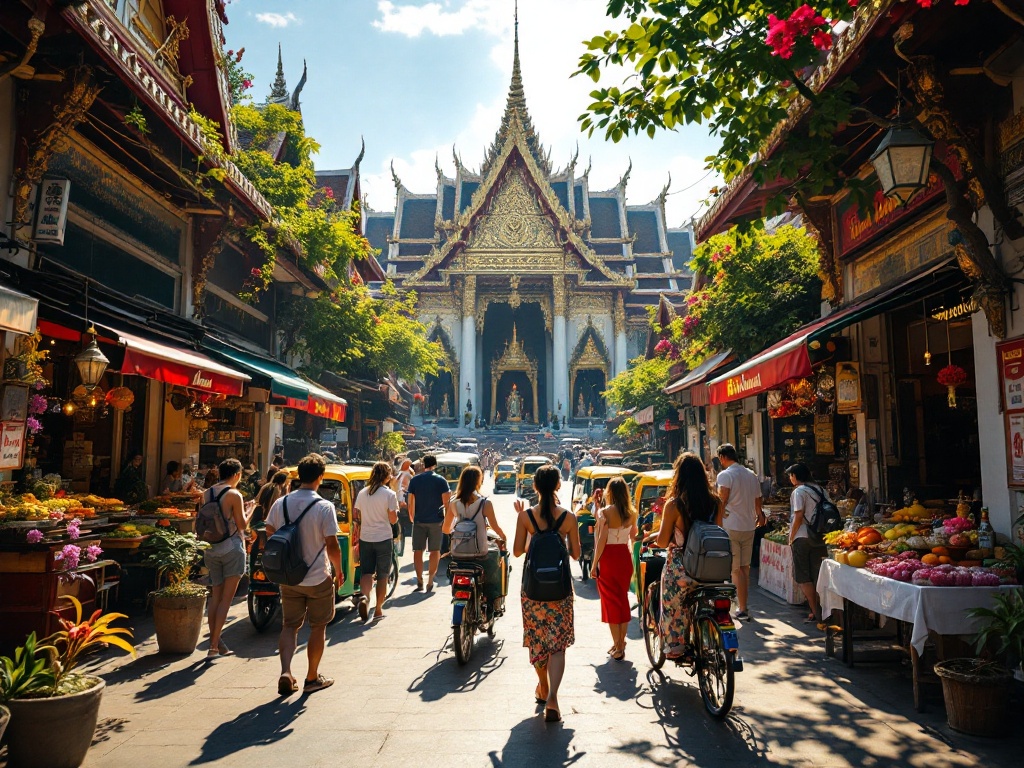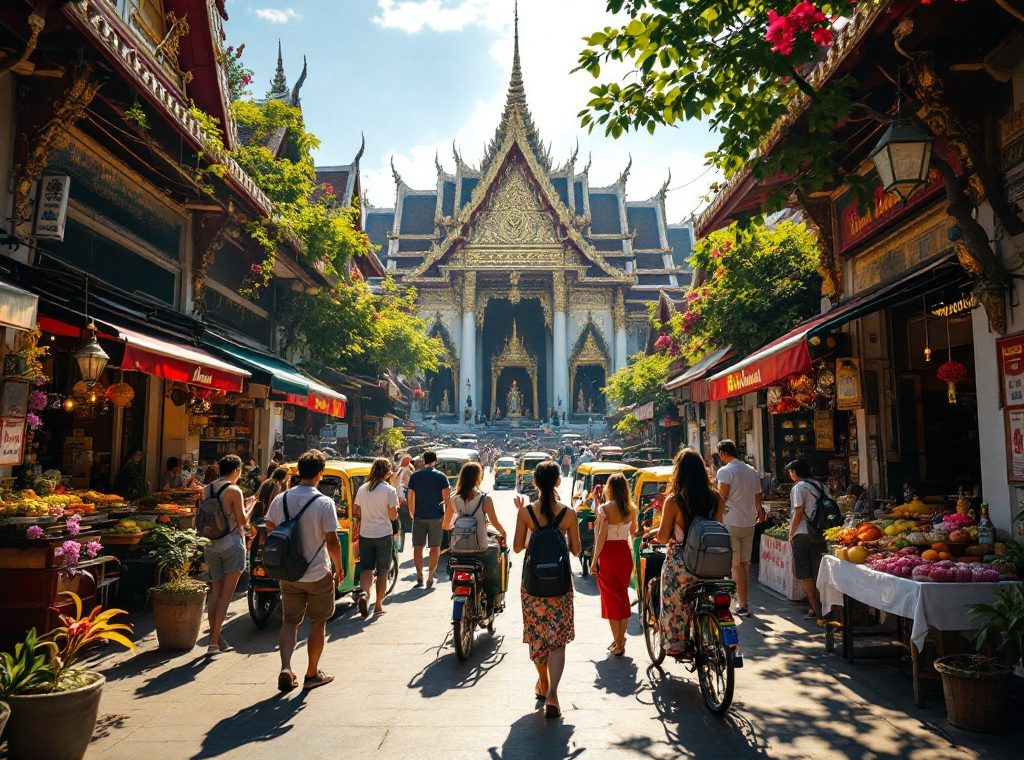Essential Things to Know before Visiting Thailand
Dreaming of Thailand’s stunning temples and vibrant culture? Discover essential tips for a smooth and enriching journey! From visa requirements for US citizens (30 days by air, 15 by land!) to respecting the monarchy and mastering the “Wai,” this guide covers everything. Learn how to navigate local customs, avoid scams, explore transportation like tuk-tuks, and savor delicious street food. Unlock the secrets to an unforgettable Thai adventure – read on to plan your perfect trip!
Important information

- Respect the Thai monarchy and avoid any disrespectful actions or words.
- Dress modestly, especially when visiting temples, covering shoulders and knees.
- Learn basic Thai phrases like “Sawasdee” (hello) and “khop khun” (thank you).
- Check visa requirements; US citizens get 15-30 days visa-free depending on arrival method.
- Carry Thai Baht (THB), especially for markets and smaller vendors, though ATMs are widely accessible.
Essential Things to Know before Visiting Thailand
Before you travel to Thailand, take some time to learn about the local customs. Showing respect for the monarchy is extremely important. Dress modestly, particularly when visiting temples. Learning basic Thai phrases will enrich your experience. Check visa requirements according to your nationality. Familiarize yourself with the Thai Baht and budget accordingly. Be aware of potential tourist scams. Travel insurance is highly recommended. Research the best time to visit, considering regional weather patterns. Explore transportation options like trains, buses, and tuk-tuks. When entering temples, remove your shoes and dress respectfully. Use the traditional “Wai” greeting. Understand local laws regarding alcohol and public displays of affection. Check recommended vaccinations and health precautions before your trip.
Respect the Monarchy. Demonstrating respect for the Thai monarchy is crucial.
Dress Modestly. Dress respectfully, especially at religious sites.
Learn Basic Thai. A few phrases can enhance your interactions.
Check Visa Requirements. Ensure you have the necessary travel documents.
Understand the Currency. Familiarize yourself with the Thai Baht.
Beware of Scams. Be aware of common tourist traps.
Get Travel Insurance. Protect yourself against unforeseen events.
Plan Your Trip:
- research the best time to visit, considering the weather,
- explore transportation options (trains, buses, tuk-tuks),
- check recommended vaccinations and health precautions.
Temple Etiquette:
- remove your shoes before entering,
- dress respectfully,
- practice the “Wai” greeting.
Be Aware of Local Laws: Understand regulations concerning alcohol and public displays of affection.
When to Travel: Best Time to Visit Thailand
Thailand is a fantastic travel destination, especially during its dry season spanning November to April. These months offer cooler temperatures and lower humidity. While the country experiences three distinct seasons, each region is affected differently by the rains. For instance, the north shines during the cooler months, while the southern islands remain inviting throughout the year.
Visa Requirements for Thailand
Planning a trip to Thailand? US citizens traveling by air can enjoy a 30-day visa-free stay. Arriving by land? Your stay is limited to 15 days. For longer visits, obtain a visa from the nearest Royal Thai Embassy or Consulate before your departure. Confirming the latest details with them beforehand is always recommended to ensure a smooth trip.
Health and Safety Considerations
For a healthy trip, consider tetanus and hepatitis A vaccinations. Thailand is generally safe, but tourists should be wary of potential scams. It’s also wise to steer clear of any protests.
Vaccinations and Health Risks
Prioritize your health when planning your trip to Thailand. Discuss essential vaccinations with your doctor, including Hepatitis A and B, Typhoid, and Japanese Encephalitis. They can provide personalized recommendations. Avoid tap water and opt for readily available bottled water.
Travel Insurance and Healthcare in Thailand
Planning a trip to Thailand? Travel insurance is a must-have. It protects you from unexpected medical costs and accidents. While Thailand has good healthcare, especially in urban areas, having insurance offers peace of mind.
Consult your doctor. Before you go, talk to your doctor about recommended vaccinations like Hepatitis A and B, Typhoid, and Tetanus.
Pack a first-aid kit. Include any essential medications you regularly take.
Choose your food and water wisely. Opt for freshly cooked street food and stick to bottled or purified water to avoid stomach issues.
Don’t forget mosquito repellent. Protect yourself from mosquito bites and potential diseases.
Safety Tips: Avoiding Political Protests and Tourist Scams
Before traveling to Thailand, research any ongoing protests or demonstrations and avoid those areas. Be wary of common scams, particularly those involving jet skis, taxis, and gemstones. To avoid disputes, always agree on prices beforehand and opt for reliable transportation options. Consider using ride-hailing apps or metered taxis for transportation. When engaging in water sports activities, thoroughly inspect equipment for any damage and document its condition to prevent being held liable for pre-existing issues. Be mindful of your belongings in crowded areas, as pickpocketing can occur. Respect local customs and traditions, such as dressing modestly when visiting temples.
Thai Culture and Etiquette
Respect Buddha Images. Refrain from touching them and avoid inappropriate poses nearby.
Dress Modestly, particularly when visiting temples.
Use the Traditional Wai Greeting. Perform it by pressing your palms together as a sign of respect.
Remove Your Shoes. Do this before entering homes and temples, a common courtesy in Thailand.
Avoid Touching Anyone’s Head. The head is considered sacred in Thai culture.
Learn Basic Thai Phrases. This demonstrates respect and enhances interactions.
Embrace “Sanuk”. This concept, meaning fun, is central to Thai culture and reflected in their enjoyment of work and social life.
Be Mindful of Cultural Norms. While known for their hospitality, Thais appreciate visitors who demonstrate cultural sensitivity.
Understanding Buddhism and Respecting Buddha Images
Respect for Buddha images and monks is essential when visiting Thailand. Avoid touching or climbing on Buddha statues, and never point your feet at them or monks. Modest dress is customary when visiting temples.
Dress Modestly: Dress Code for Temples and Monks
When visiting Thai temples, respectful attire is essential. This includes covering your shoulders and knees as a sign of reverence for Thai customs and Buddhist traditions. Appropriate clothing options include long pants or skirts that fall below the knee, and shirts that cover the shoulders. Avoid sleeveless tops, shorts, and tight-fitting clothing like tank tops and short skirts. Additionally, refrain from wearing clothing displaying potentially offensive images or slogans. Modest dress ensures a respectful and positive cultural experience. Here’s a quick guide for appropriate temple attire:
- Recommended attire: long pants, below-the-knee skirts, shirts covering shoulders.
- Clothing to avoid: sleeveless tops, shorts, tight-fitting clothing (tank tops, short skirts), clothing with offensive images or slogans.
Dressing respectfully ensures a positive cultural experience when visiting Thai temples.
Cultural Etiquette: The Wai and Greeting Locals
When greeting someone in Thailand, show respect with a wai. Simply press your palms together in a prayer-like gesture and bow slightly. This traditional greeting is both polite and appreciated. Avoid touching anyone’s head, as it’s considered sacred. Dress modestly, particularly when visiting temples. Remember to remove your shoes before entering homes and some businesses. Learning a few Thai phrases, such as “Sawasdee” (hello), can also enrich your interactions.
Language and Communication
While English is widely spoken in Thailand’s tourist hubs and cities, learning a few Thai phrases can significantly enhance your travel experience. Simple greetings like “Sawasdee” (hello), “khop khun” (thank you), and “mai pen rai” (you’re welcome) can create positive interactions. Phrasebooks and translation apps are also valuable tools for bridging communication gaps. Even though you’ll likely find English speakers, knowing some basic Thai can truly enrich your time in Thailand.
Simple Thai Phrases and English Usage
Useful Thai phrases for travelers:
Greetings: sawasdee (hello)
Expressing gratitude: khop khun (thank you)
Responding to thanks: mai pen rai (you’re welcome)
Polite requests (female/male): Add “kha/khrap.” For example, “khor thoht kha/khrap” (excuse me)
While English is often spoken in tourist areas, learning basic Thai phrases can significantly enrich your travel experience. It shows respect for the local culture and allows for more meaningful interactions with Thai people.
Transportation in Thailand
Traveling across Thailand offers a range of transport options. For long distances, consider: trains, coaches, and flights. Shorter journeys allow you to experience local transport such as: tuk-tuks, scooters, and longtail boats.
Getting Around Bangkok
Bangkok offers efficient travel via the BTS Skytrain and MRT subway. Taxis are also readily available, but remember to negotiate the fare beforehand or ensure the meter is running.
Intercity Travel
Buses and trains provide convenient links between major cities. For reaching islands or more remote parts of Thailand, domestic flights are a time-saving option.
Scooter rentals are a popular way to explore independently, but always ensure you have the required licenses and insurance before hitting the road. Finally, remember to factor in potential traffic delays, especially during peak hours, when planning your journeys.
Public Transport Options: Trains, Coaches, and Flying
Traveling around Thailand offers diverse public transport choices. For budget-conscious long-distance trips, consider the State Railway of Thailand, offering first, second, and third-class train carriages. Coaches also cover extensive routes throughout the country. To quickly reach islands, flying is often the best option. Popular destinations such as Phuket, Koh Samui, and Phi Phi are served by various airlines, including Thai Airways, Bangkok Airways, and AirAsia. For shorter journeys, readily available and affordable buses and songthaews are excellent choices.
Getting Around Locally: Tuk-Tuks, Scooters, and Longtail Boats
Tuk-tuks are ideal for short hops.
Scooters offer convenient independent travel, making them a popular personal transportation choice.
Longtail boats, common in coastal regions and islands, navigate waterways and provide access to neighboring islands.
Currency and Budgeting
In Thailand, the official currency is the Thai baht (THB). While credit and debit cards are accepted in larger establishments like hotels and restaurants (though sometimes with fees), cash is preferred, particularly in local markets and smaller shops. ATMs are widely available for convenient cash withdrawals. Don’t be afraid to haggle respectfully at market stalls; it’s a common practice and a great way to save money.
Using the Thai Baht: Cash vs. Credit/Debit
In Thailand, cash is essential, especially at local markets, small shops, and for paying tuk-tuk drivers. While larger businesses, such as hotels and malls, readily accept credit cards, having cash on hand is always recommended. ATMs are widely available, making withdrawing money convenient. However, it’s a good idea to notify your bank of your travel plans to avoid any issues with your cards.
Bargaining Tips and Tourist Pricing
Haggling is a common practice in Thai markets. Tourists are often greeted with inflated initial prices, but don’t be discouraged. A polite counter-offer can often secure a much better deal. It’s simply part of the shopping culture. Respectfully offering perhaps half the asking price is a good starting point for negotiation. A friendly smile and pleasant demeanor can also be quite effective. Here’s how to haggle effectively:
Understand the culture. Haggling is expected in Thai markets, it’s a friendly exchange, not a confrontation.
Start low. Offer about half the initial asking price. This gives you room to negotiate upwards.
Be respectful. Smile, be polite, and engage in friendly banter. A positive attitude goes a long way.
Know your walk-away price. Have a maximum price in mind and be prepared to walk away if the vendor won’t meet it.
Enjoy the process. Haggling is part of the fun of shopping in Thailand. Embrace the experience.
Accommodation and Food
Thailand’s street food scene offers a delicious and safe culinary adventure. Countless vendors serve up a diverse menu, with fantastic vegetarian options readily available. For the freshest meals, be sure to familiarize yourself with local meal times.
Finding Safe and Delicious Street Food
Choose busy food stalls. Their high turnover rate is a good sign of fresh ingredients and popular dishes.
Observe food preparation. Select vendors who maintain a clean workspace and cook food thoroughly.
Start with smaller portions. This allows you to sample a wider variety of dishes, especially when trying unfamiliar cuisine.
Avoid raw or undercooked meat and seafood. Favor dishes cooked to order at high temperatures, such as stir-fries or grilled meats.
Peel your fruit. This minimizes contamination risk.
Stick to bottled water. If bottled water isn’t an option, verify the safety of the water source.
Prioritize hygiene. Use hand sanitizer and clean your hands before and after meals.
Vegetarian Options and Meal Times
Vegetarian travelers will find Thailand a welcoming destination. Numerous restaurants offer meat-free dishes, often featuring tofu and vegetable substitutes. Entirely vegetarian restaurants are also common, particularly in cities and tourist areas. Look for signs with the Thai word “jay,” indicating vegetarian food prepared without meat, fish sauce, or garlic.
Meal Times in Thailand
Meal times are flexible in Thailand.
- Breakfast is typically enjoyed between 6:30 am and 9:30 am.
- Lunch is served from 11:30 am to 2:00 pm.
- Dinner is usually eaten between 6:00 pm and 9:00 pm.
Other Food Options
Street food vendors often operate late into the night, making late-night snacks easy to find. Fresh produce and ingredients are plentiful in local markets, allowing you to easily prepare your own vegetarian meals.
Tourist Attractions and Activities
Phuket attracts tourists with its stunning beaches, vibrant nightlife, and luxurious resorts, making it a popular tourist destination. For breathtaking scenery, the Phi Phi Islands are a must-see. Take a boat tour, go snorkeling, and soak in the stunning vistas.
- Stunning beaches,
- vibrant nightlife,
- luxurious resorts.
Koh Samui offers a more tranquil escape, known for its high-end resorts and rejuvenating wellness retreats. Booking tours and activities in advance, especially during peak season, is highly recommended to secure your spot.
- Tranquil escape,
- high-end resorts,
- rejuvenating wellness retreats.
Must-Visit Places: Phuket, Koh Samui, and Phi Phi Islands
Phuket’s nightlife pulsates with energy, and Patong Beach remains an iconic destination for those seeking vibrant entertainment.
Koh Samui offers a diverse range of experiences, from luxurious resorts catering to relaxation to vibrant full moon parties for those seeking energetic revelry.
The Phi Phi Islands entice visitors to snorkel in pristine waters and explore the stunning Maya Bay, an unforgettable adventure amidst natural beauty.

















